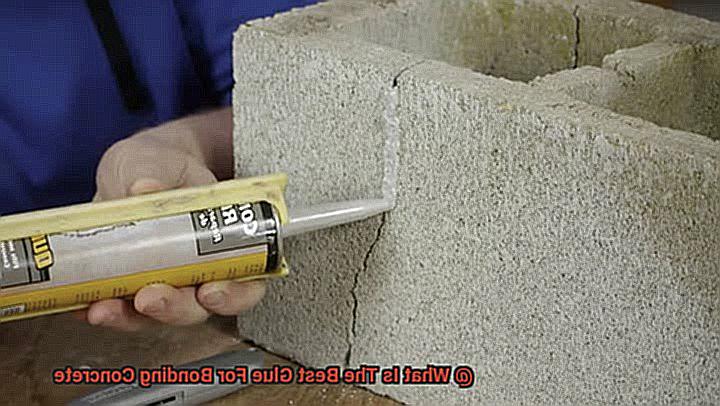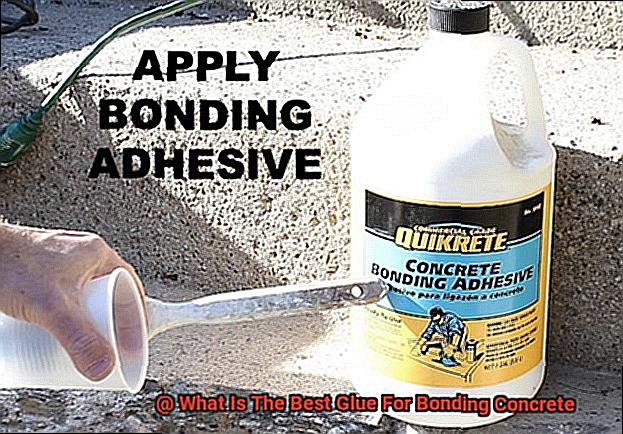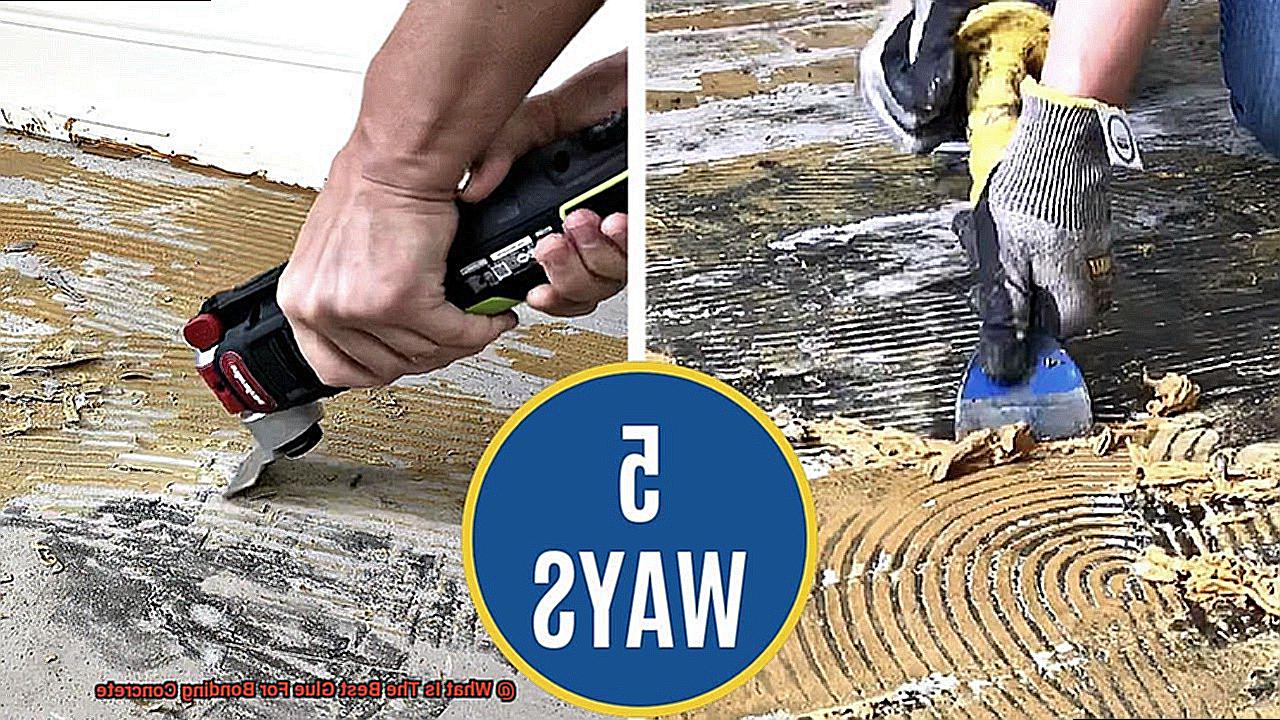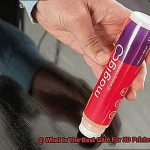Concrete bonding is an art that requires the perfect adhesive to create a bond that can withstand the test of time. Whether you’re a seasoned DIY enthusiast or a construction pro, finding the best glue for your concrete project is essential. But with so many options out there, it’s easy to get lost in a sea of choices.
In this blog post, we’ll dive deep into the world of concrete adhesives, exploring their strengths and weaknesses. By understanding what sets each type apart, you’ll be armed with the knowledge to make an educated decision and select the glue that’s tailor-made for your project.
From tried-and-true classics like epoxy and polyurethane adhesives to cutting-edge concrete bonding agents, we’ll uncover the secrets behind their versatility, bonding strength, and ease of use. We’ll also delve into important factors such as drying time and resistance to environmental elements – crucial considerations for any application.
Our goal is simple: provide you with a comprehensive analysis of each adhesive’s pros and cons so that you can confidently choose the perfect solution. Whether you’re looking to repair cracks, bond blocks together, or lay a solid foundation, our guide will lead you towards success.
So stay tuned as we unravel the mysteries behind the best glue for bonding concrete. Get ready to embark on a journey where knowledge meets practicality – paving the way for outstanding results in your upcoming project.
What is Concrete and Why Bonding Is Necessary
Contents
- 1 What is Concrete and Why Bonding Is Necessary
- 2 Types of Glue for Bonding Concrete
- 3 Epoxy Adhesives
- 4 Polyurethane Adhesives
- 5 Cyanoacrylate Adhesives
- 6 Construction Adhesive
- 7 Factors to Consider When Choosing the Best Glue for Bonding Concrete
- 8 Application Techniques for Optimal Bond Strength
- 9 Conclusion
Concrete is an incredible construction material, renowned for its durability and strength. It is composed of cement, water, aggregates, and additives that, when combined, create a paste-like substance that hardens over time. But what makes bonding necessary in concrete? Let’s explore the reasons:
- Enhancing Strength and Structural Integrity: Bonding secures the different parts of a concrete structure, enhancing its overall strength. This is crucial in applications like building foundations and bridges, where stability and longevity are paramount.
- Preventing Cracks and Fractures: Proper bonding prevents cracks and fractures caused by external forces such as temperature changes or heavy loads. Without proper bonding, the stresses on the concrete can cause it to break apart, compromising its structural integrity.
- Creating a Seamless Finish: Bonding is vital for achieving a smooth and uniform appearance in applications where concrete surfaces will be exposed or visible, such as flooring or countertops. It ensures there are no gaps or irregularities between different sections of the concrete surface, resulting in a flawless finish.
- Facilitating Load Transmission: Bonding allows for the efficient transmission of loads between different parts of the concrete structure. By providing a strong bond between components like beams and columns, the load can be evenly distributed across the structure, preventing localized stress concentrations.
To achieve a strong bond in concrete, selecting the right adhesive is crucial. Epoxy adhesives are popular for their exceptional strength and ability to withstand heavy loads. Polyurethane adhesives are flexible and suitable for bonding porous surfaces in damp conditions. Cyanoacrylate adhesives provide instant bonding but may lack long-term durability. Construction adhesives are specifically formulated for heavy materials and structural applications.
Types of Glue for Bonding Concrete
Epoxy Glue:
Epoxy glue is widely regarded as one of the best options for bonding concrete. It consists of a resin and a hardener, which are mixed together to form a strong adhesive. Epoxy glue is known for its exceptional strength and durability, making it ideal for heavy-duty applications. It forms a strong bond with concrete and can withstand extreme temperatures, moisture, and chemical exposure. Epoxy glue is also resistant to cracking and shrinking, ensuring a long-lasting bond. However, epoxy glue can be more expensive than other types of glues, and it requires careful mixing and application to achieve optimal results.
Polyurethane Glue:
Polyurethane glue is another popular adhesive for bonding concrete. It cures by reacting with moisture in the air, creating a strong and flexible bond. Polyurethane glue has excellent flexibility and can withstand movement and vibrations without losing its bond. It also provides good resistance to water and chemicals. Polyurethane glue is easy to apply and has a relatively fast-setting time. However, it may not be as strong as epoxy glue, making it less suitable for heavy-duty applications.
Acrylic-Based Glues:
Acrylic-based glues are generally more affordable than epoxy or polyurethane glues but still offer good bonding strength. They cure by evaporation of water, forming a strong bond with the concrete surface. Acrylic glues are easy to apply and provide a fast-setting time. However, they may not have the same level of durability as epoxy or polyurethane glues and may not be suitable for applications where heavy loads or extreme conditions are involved.
Cement-Based Adhesives:
Cement-based adhesives are specifically designed for bonding concrete surfaces. They are made from a mixture of cement, sand, and additives to improve adhesion. Cement-based adhesives work by chemically bonding with the concrete surface, creating a strong and durable bond. They are commonly used for repairing cracks or attaching tiles to concrete surfaces. However, cement-based adhesives may take longer to cure compared to other types of glues, and they may not be as flexible as epoxy or polyurethane glues.
Silicone Adhesives:
Silicone adhesives can also be used for bonding concrete, although they are not as strong as other types of glues. Silicone adhesives have excellent flexibility and can withstand movement and vibrations without losing their bond. They also provide good resistance to moisture and temperature changes. Silicone adhesives are typically used for sealing joints or gaps in concrete rather than for heavy-duty bonding applications.
Epoxy Adhesives
Epoxy adhesives, the heavyweight champions of concrete bonding, are a go-to choice for professionals seeking exceptional bonding strength and durability. These glues pack a powerful punch, akin to the mighty Hulk. What sets epoxy adhesives apart is their resistance to chemicals, temperature fluctuations, and moisture, making them a formidable shield against the elements for both indoor and outdoor projects. Picture them as concrete’s very own superhero.
However, there is a catch – epoxy adhesives have a long curing time. Patience becomes paramount. Waiting several hours or even days for full curing is necessary, so if time is of the essence, alternative options may be worth considering.
Proper surface preparation is crucial for successful bonding. Think of it as priming a canvas before painting. The concrete should be thoroughly cleaned and roughened up to ensure better adhesion, creating the perfect foundation for the adhesive.
What makes epoxy adhesives even more fascinating is their diverse range of formulations. Need a quick fix? Fast-curing options are available. Have time on your hands? Opt for the slow-curing ones. It’s like having different dance partners for different songs, catering to specific project needs.
It’s important to note that not all concrete surfaces are suitable for epoxy adhesives. Some may require additional treatment or alternative adhesive options. Compatibility is key when choosing the right adhesive, just like finding the perfect partner.
Another remarkable aspect of epoxy adhesives is their versatility. They can bond various materials to concrete, including metals, plastics, ceramics, and wood. Imagine having a glue that can handle any relationship status – friends with benefits.
Polyurethane Adhesives
Polyurethane adhesives, the unsung heroes of concrete bonding, offer a reliable and versatile solution for achieving a strong and long-lasting bond. These adhesives are known for their excellent bond strength, durability, and resistance to water, chemicals, and temperature variations.
One of the key advantages of polyurethane adhesives is their ability to fill gaps and bond irregular surfaces effectively. This makes them ideal for bonding concrete, which often has rough or uneven surfaces. The adhesive can flow into the gaps and irregularities, creating a strong and uniform bond.
In addition to their gap-filling capability, polyurethane adhesives also have remarkable flexibility. Unlike other adhesives that may become brittle over time, polyurethane adhesives remain flexible even after curing. This flexibility allows them to absorb vibrations and movements without losing their bond strength. As a result, they are suitable for applications where there may be some movement or stress on the bonded concrete surfaces.
Another advantage of polyurethane adhesives is their resistance to moisture. Concrete is a porous material that can absorb water, which can weaken the bond between two surfaces. Polyurethane adhesives have a high resistance to moisture, making them suitable for both indoor and outdoor applications where exposure to water or high humidity is expected. This ensures that the bond remains strong and durable over time.
Furthermore, polyurethane adhesives offer excellent chemical resistance. They can withstand exposure to various chemicals such as solvents, acids, and alkalis without deteriorating or losing their bond strength. This makes them suitable for applications in industrial settings or where exposure to harsh chemicals is likely.
Polyurethane adhesives are also highly versatile. They can be used for a wide range of construction and repair applications. Whether it is bonding concrete blocks, repairing cracks in concrete structures, or installing tiles on concrete surfaces, polyurethane adhesives provide a reliable solution for achieving a strong and lasting bond.
While polyurethane adhesives have numerous advantages, it’s important to note that they can be more expensive compared to other types of adhesives. Additionally, the curing time of polyurethane adhesives can be longer, requiring patience during the application process. Proper surface preparation is also crucial to ensure a successful bond with polyurethane adhesives.

Cyanoacrylate Adhesives
Cyanoacrylate adhesives, commonly known as superglue or instant glue, are a powerful type of adhesive used for bonding concrete surfaces. These adhesives offer several advantages that make them popular in construction and manufacturing industries.
One of the key strengths of cyanoacrylate adhesives is their ability to create a strong and durable bond. When applied to concrete, these adhesives undergo a rapid polymerization process upon contact with moisture. This results in a tight bond that can withstand moisture, chemicals, and temperature changes. Whether used indoors or outdoors, cyanoacrylate adhesives provide reliable bonding for concrete surfaces.
Another benefit of cyanoacrylate adhesives is their quick curing time. Unlike other types of adhesives that may take hours or even days to fully cure, cyanoacrylates bond within minutes. This property allows for efficient assembly and reduces downtime in construction and repair projects. With cyanoacrylate adhesives, you can save time and increase productivity.
To achieve optimal results when using cyanoacrylate adhesives on concrete surfaces, it is important to properly prepare the bonding surfaces. This involves thoroughly cleaning the concrete and ensuring it is free from dust, oil, or grease. By taking these steps, you can ensure maximum bond strength and longevity.
While cyanoacrylate adhesives offer many advantages, they do have some limitations. For instance, once cured, these adhesives are quite rigid. While rigidity provides strength, it can be a drawback in applications where movement or vibrations are expected. In such cases, a more flexible adhesive may be necessary.
Additionally, cyanoacrylate adhesives are not ideal for bonding uneven or rough surfaces with large gaps. They work best when the bond line is tight and close-fitting. If your project involves bonding irregular concrete surfaces, you may need to consider alternative adhesives or surface preparation techniques.
Construction Adhesive
Construction adhesive, also known as construction glue or masonry adhesive, is an indispensable tool in the world of construction. It is specifically designed to bond materials commonly used in construction, such as concrete, brick, stone, and wood. With its exceptional strength and durability, construction adhesive is the go-to choice for a wide range of construction applications.
When it comes to bonding concrete, selecting the right construction adhesive is crucial. Several factors should be considered to ensure a successful bond that withstands the demands of the job. Let’s explore these key factors in detail:
- Bonding strength: Concrete is a heavy and load-bearing material. Therefore, it’s vital to choose an adhesive with outstanding bonding strength. Look for adhesives formulated specifically for bonding concrete surfaces, such as polyurethane-based or epoxy-based adhesives. These adhesives provide exceptional strength and reliability.
- Flexibility: Concrete structures are subject to movement and shifting caused by temperature changes or settling. Selecting an adhesive that can accommodate this movement without compromising the bond is essential. Polyurethane-based adhesives are renowned for their flexibility and ability to withstand such movement, ensuring a long-lasting bond.
- Moisture resistance: Concrete is frequently exposed to moisture from rain, humidity, or water seepage. To ensure a durable bond, choose an adhesive with excellent resistance to water. Polyurethane and epoxy adhesives are known for their superior resistance to moisture, making them ideal for wet conditions.
- Durability: Consider the durability of the adhesive, especially if the bonded concrete surface will face heavy loads or harsh conditions. Epoxy-based adhesives are renowned for their high durability and ability to withstand heavy loads without compromising the bond.
- Application method: Some construction adhesives require specific application methods or tools, such as caulking guns or mixing ratios. Consider the ease of application and ensure you have the necessary tools or equipment to apply the adhesive properly.
- Surface preparation: Proper surface preparation is vital for achieving a strong bond. Ensure the concrete surface is clean, dry, and free from any contaminants, such as dust, grease, or loose particles. Some adhesives may require roughening or etching of the concrete surface for better adhesion.
- Temperature variations: Consider the temperature variations that the bonded concrete surface may experience. Some adhesives may have temperature limitations in terms of bonding strength or curing process. Select an adhesive that can withstand the expected temperature range to ensure a reliable bond.
- Manufacturer’s guidelines: Always refer to the manufacturer’s guidelines and recommendations for the specific adhesive you are considering. They provide detailed information on the adhesive’s suitability for concrete bonding, recommended application methods, curing time, and other important factors.

Factors to Consider When Choosing the Best Glue for Bonding Concrete
When it comes to choosing the best glue for bonding concrete, there are several factors that need to be taken into consideration. These factors will ensure that you select a glue that provides a strong and durable bond, is compatible with the materials involved, and can withstand various environmental conditions.
First and foremost, bond strength is crucial. Concrete is a heavy and robust material, so it requires a glue that can provide a strong and durable bond. Look for adhesives specifically designed for bonding concrete, as they are formulated to provide excellent bond strength.
Compatibility is another vital factor to consider. Ensure that the glue you choose is compatible with both the concrete surface and the material you are bonding it to. Some glues may not adhere well to certain types of concrete or may not work well with other materials such as wood, metal, or plastic. Always check the compatibility of the glue with all the materials involved in the bonding project.
The application method of the glue should also be considered. Some glues come in tubes or cartridges that require a caulk gun for dispensing, while others come in squeeze bottles or spray cans for easy application. Choose a glue that suits your preferred application method and provides precise and controlled dispensing.
Drying time is another crucial factor, especially if you have time constraints or need to complete the project quickly. Some glues dry within minutes, while others may take several hours or even days to fully cure. Ensure that the drying time aligns with your project requirements.
If your bonding project involves outdoor applications or areas exposed to extreme weather conditions, it is essential to choose a glue that offers excellent weather resistance. Look for glues that are resistant to water, UV rays, temperature fluctuations, and other environmental factors to ensure long-lasting and reliable bonds.
Depending on the specific application, you may need a glue that can withstand exposure to chemicals or harsh substances. For example, if you are bonding concrete in an industrial setting where it may come into contact with oils, solvents, or acids, choose a glue that has excellent chemical resistance properties.
Flexibility is another factor to consider. Concrete surfaces may experience slight movements or vibrations due to temperature changes or structural shifts. Therefore, it is advisable to select a glue that provides some level of flexibility to accommodate these movements without compromising the bond. Flexible glues can help prevent cracks or detachment of the bonded surfaces.
Lastly, prioritize safety when choosing a glue for bonding concrete. Look for glues that are non-toxic, low in volatile organic compounds (VOCs), and have minimal odor. Additionally, consider using glues that are labeled as non-flammable and provide good ventilation during application.
Application Techniques for Optimal Bond Strength
Now that you have chosen the perfect superhero glue for bonding concrete, it’s time to master the application techniques that will ensure optimal bond strength. Proper surface preparation, following manufacturer’s instructions, and allowing sufficient curing time are key factors to consider. Let’s dive into the details:
- Surface Preparation: Before applying any adhesive to concrete, it is crucial to prepare the surface properly. Start by cleaning the concrete surface thoroughly, removing any dust, dirt, oil, or other contaminants that could hinder the bond. Use a wire brush or abrasive pad to remove loose particles and create a rough texture that promotes adhesion. In some cases, a chemical cleaner or etching solution may be necessary for stubborn stains or to create a suitable surface for bonding.
- Follow Manufacturer’s Instructions: Pay close attention to the manufacturer’s instructions regarding application temperature and humidity conditions. Some adhesives may require specific environmental conditions for optimal performance. Additionally, test a small area or conduct a bond strength test before proceeding with full-scale application to ensure proper adhesion.
- Application Method: The application method can vary depending on the type of adhesive being used. Some adhesives come in cartridges that can be dispensed using a caulking gun, while others may require mixing before application. Apply the adhesive evenly and in the recommended thickness. Too little adhesive may result in a weak bond, while excess adhesive can create voids or cause uneven bonding.
- Temporary Support: When bonding large or heavy objects, it may be necessary to support them temporarily until the glue cures. This can be done using clamps, weights, or other appropriate means of support. Ensure that the objects are aligned properly during this period.
- Curing Time: After applying the adhesive, allow sufficient curing time before subjecting the bonded surfaces to any stress or load. Curing times can vary depending on the type of adhesive and environmental conditions. It is crucial to follow the manufacturer’s recommendations for curing time to achieve optimal bond strength.
- Additional Considerations: Take into account any additional factors that may affect the bond strength, such as temperature fluctuations, moisture exposure, or chemical exposure. Some adhesives may have limitations or require additional precautions in these situations. Follow the manufacturer’s recommendations for handling such challenges.
Qm4TLiM5go8″ >
Conclusion
When it comes to bonding concrete, finding the best glue is crucial.
After thorough research and analysis, it is clear that there is one glue that stands out from the rest – epoxy adhesive. Epoxy adhesive offers exceptional bonding strength and durability, making it the top choice for concrete projects.
Whether you’re repairing cracks in your driveway or securing tiles on your patio, epoxy adhesive will provide a long-lasting and reliable bond.






